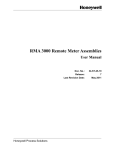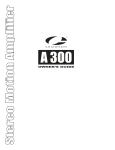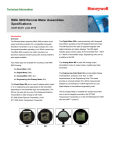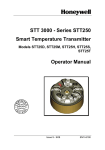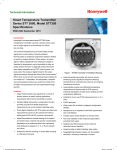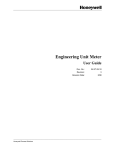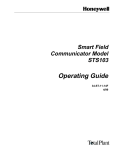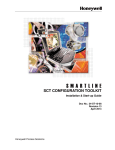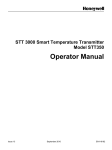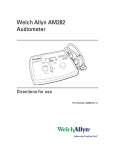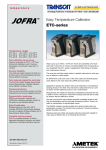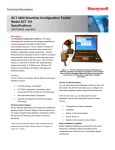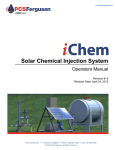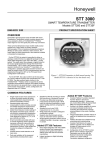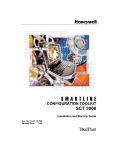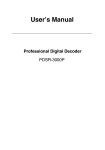Download RMA 3000 Remote Meter Assemblies User Manual
Transcript
RMA 3000 Remote Meter Assemblies User Manual Doc. No.: 34-ST-25-19 Release: 3 Last Revision Date: 9/05 _________________________________________________________________________________________________________ Industrial Measurement and Control Notices and Trademarks Copyright 2004 by Honeywell International Inc. Release 3 September, 2005 Warranty/Remedy Honeywell warrants goods of its manufacture as being free of defective materials and faulty workmanship. Contact your local sales office for warranty information. If warranted goods are returned to Honeywell during the period of coverage, Honeywell will repair or replace without charge those items it finds defective. The foregoing is Buyer's sole remedy and is in lieu of all other warranties, expressed or implied, including those of merchantability and fitness for a particular purpose. Specifications may change without notice. The information we supply is believed to be accurate and reliable as of this printing. However, we assume no responsibility for its use. While we provide application assistance personally, through our literature and the Honeywell web site, it is up to the customer to determine the suitability of the product in the application. Industrial Measurement & Control Honeywell 1100 Virginia Drive Fort Washington, PA 19034 Honeywell is a U.S. registered trademark of Honeywell Other brand or product names are trademarks of their respective owners. ii 34-ST-25-19 RMA 3000 Remote Meter Assemblies User Manual Release 3 9/05 About This Document Revision Notes The following list provides notes concerning all revisions of this document. Doc ID Rel ID 34-ST-25-19 Date Notes Release 0 11/28 First issue of document. Release 1 6/25/04 Revised Appendix A, ATEX Directive 94/9/EC Release 2 8/19/05 Revised Appendix A, D Release 3 9/1/05 Revised Appendix C Contacts World Wide Web The following lists Honeywell’s World Wide Web sites that will be of interest to our industrial automation and control customers. Honeywell Organization WWW Address (URL/e-mail) Corporate http://www.honeywell.com Industrial Measurement and Control http://content.honeywell.com/imc/ International http://www.honeywell.com/Business/global.asp Field Instruments http://www.field-measurement.com Technical Assistance Center [email protected] (e-mail) Telephone Contact us by telephone at the numbers listed below. Organization United States and Canada Release 3 9/05 Phone Number Honeywell Inc. Industrial Automation and Control 1-800-343-0228 1-800-525-7439 Technical Assistance Center 1-800-423-9883 Solution Support Center 1-602-313-3578 Asia Pacific Honeywell Asia Pacific Inc. Hong Kong (852) 8298298 Europe Honeywell PACE Brussels, Belgium [32-2] 728-2111 Latin America Honeywell Inc. Sunrise, Florida U.S.A. (305) 364-2355 34-ST-25-19 RMA 3000 Remote Meter Assemblies User Manual Sales Service iii iv 34-ST-25-19 RMA 3000 Remote Meter Assemblies User Manual Release 3 9/05 Contents CE Conformity (Europe) Notice for Remote Meter Assemblies (RMA)..... vii About Conformity and Special Conditions......................................................................vii RMA 3000 Description ...............................................................................1 Function and Design........................................................................................................ 1 Meter Types - Options ................................................................................................. 2 Installation in Hazardous Locations................................................................................. 5 Wiring-Port Seals at Remote Housing ......................................................................... 5 SM Meter Assembly..................................................................................................... 6 Specific Parameters of the Mode of Protection (Intrinsic Safety) ................................ 6 Approvals/Certifications ............................................................................................... 7 Approvals for Specific Configurations – Certified Drawings ........................................ 9 List of Certified Engineering Drawings – Wiring Diagrams........................................ 10 Wiring Drawings - Overview....................................................................................... 12 SM Meter Assembly................................................................................................... 17 Specific Parameters of the Mode of Protection (Intrinsic Safety) .............................. 17 Approvals/Certifications ............................................................................................. 18 Installation in Non-Hazardous Locations....................................................................... 20 Multiple Remote Meters ............................................................................................. 20 Appendix A – ATEX Directive 94/6/EC.....................................................21 DECLARATION OF CONFORMITY .......................................................................... 27 CERTIFICATE OF MANUFACTURER ...................................................................... 29 Appendix B - Hazardous Location Wiring.................................................31 North America ............................................................................................................ 31 Cable Systems for Division 1 / Zone 1 and Division 2 / Zone 2................................. 31 Appendix C - Hazardous Locations Reference ........................................33 Reference Information ............................................................................................... 33 North American Classification of Hazardous Locations............................................. 33 Electrical Codes ......................................................................................................... 33 Classifications ............................................................................................................ 33 Divisions 33 Examples ................................................................................................................... 33 Groups 34 Methods of Protection ................................................................................................ 35 Apparatus Parameters ............................................................................................... 36 Entity Concept............................................................................................................ 37 About IEC................................................................................................................... 39 Zones 39 IEC Groups ................................................................................................................ 39 IEC Methods of Protection......................................................................................... 40 IEC Temperature Classification ................................................................................. 41 Certification and Conformity Details .......................................................................... 41 Release 3 9/05 34-ST-25-19 RMA 3000 Remote Meter Assemblies User Manual v Certification and Conformity Details .......................................................................... 42 NEMA and IEC Recognition ...................................................................................... 43 IEC Classifications ..................................................................................................... 43 NEMA Standards ....................................................................................................... 43 IEC Designations ....................................................................................................... 43 IEC Designations, continued ..................................................................................... 44 Tables Table 1 Certified Engineering Drawings – Wiring Diagrams ....................................................................................10 Table 2 Wiring Overview: SM/ST 3000 Transmitter without HART Option ............................................................13 Table 3 Wiring Overview: SM/ST 3000 Transmitter with HART Option .................................................................14 Table 4 Wiring Overview: ME/ST 3000 Transmitter with or without HART Option................................................15 Table 5 Wiring Overview: DM/ST 3000 (Not Approved for HART) ........................................................................16 Table 6 Factory Mutual (FM) Approval .....................................................................................................................37 Table 7 Canadian Standards Association (CSA) ........................................................................................................38 Table 8 ATEX / LCIE Certification ...........................................................................................................................41 Table 9 Standards Australia (LOSC) Certification .....................................................................................................42 Table 10 Zone 2 (Europe) Declaration of Conformity ...............................................................................................42 Table 11 NEMA Enclosure Type Numbers and Comparable IEC Enclosure Classification.....................................44 Figures Figure 1 Overview of RMA Configuration ..................................................................................................................1 Figure 2 Highlights of Meter Features..........................................................................................................................2 Figure 3 Examples of Typical Conduit Fittings............................................................................................................5 Figure 4 Example of Sealed Cable Gland.....................................................................................................................5 Figure 5 SM Meter Assembly for CE Mark .................................................................................................................6 Figure 6 RMA 3000 Intrinsic Safety Parameters..........................................................................................................7 Figure 7 Stylized Sample of Certified Engineering Drawing .......................................................................................9 Figure 8 Legend for Wiring Diagrams Overview.......................................................................................................12 Figure 9 SM 3000 Meter Assembly for CE Mark ......................................................................................................17 Figure 10 RMA 3000 Intrinsic Safety Parameters......................................................................................................18 vi 34-ST-25-19 RMA 3000 Remote Meter Assemblies User Manual Release 3 9/05 CE Conformity (Europe) Notice for Remote Meter Assemblies (RMA) About Conformity and Special Conditions This product is in conformity with the protection requirements of 89/336/EEC, the EMC Directive, and of 94/9/EC, the Explosive Atmospheres (ATEX) Directive. Conformity of this product with any other “CE Mark” Directive(s) shall not be assumed. Deviation from the installation conditions specified in this manual, and the following special conditions, may invalidate this product’s conformity with the EMC Directive. • Shielded, twisted-pair cable such as Belden 9318 must be used for all signal/power wiring. • The shield must be connected to ground at only one end of the cable. Connect it to the power supply and the meter sides of the wiring; leave the shield insulated at the transmitter side of the wiring. ATTENTION The emission limits of EN 50081-2 are designed to provide reasonable protection against harmful interference when this equipment is operated in an industrial environment. Operation of this equipment in a residential area may cause harmful interference. This equipment generates, uses, and can radiate radio frequency energy and may cause interference to radio and television reception when the equipment is used closer than 30 meters (98 feet) to the antenna(e). In special cases, when highly susceptible apparatus is used in close proximity, the user may have to employ additional mitigating measures to further reduce the electromagnetic emissions of this equipment. Release 3 9/05 34-ST-25-19 RMA 3000 Remote Meter Assemblies User Manual vii viii 34-ST-25-19 RMA 3000 Remote Meter Assemblies User Manual Release 3 9/05 RMA 3000 Description Function and Design The Honeywell RMA 3000 Remote Meter Assemblies provide various means of remote-mounting a meter that is associated with a Honeywell Smartline Transmitter or a compatible non-Honeywell transmitter. The RMA 3000 includes a remote meter housing that can be used in hazardous environments or in ordinary environments. When used in hazardous environments, the remote housing must be configured as a flameproof/explosion-proof housing, in which all points of entrance and exit for wiring are protected and sealed via rigid metal conduit or suitable cable gland fittings. Three meter styles are available, and with a few exceptions any of these may be connected in either of two basic physical/wiring configurations, as indicated in Figure 1. Figure 1 Overview of RMA Configuration Release 3 9/05 34-ST-25-19 RMA 3000 Remote Meter Assemblies User Manual 1 That is, the explosion-proof housing may be located - at the end of a wiring run for the transmitter loop, or - between the transmitter and the receiver devices. This manual includes several sets of Honeywell-certified engineering drawings that specify RMA 3000 configurations and conditions that are approved for use in hazardous environments by various approval agencies (FM, CSA, and LCIE (CENELEC/ATEX). Each of these drawings shows a configuration similar to that shown in Figure 1; that is, a single meter connected remote from a single transmitter. In some selected cases (such as operation in non-hazardous locations), it is possible to connect more than one meter to a given transmitter. In these cases, the additional meter(s) may be placed either at the end of a wiring run, or at any location between the transmitter and other elements of the Remote Meter Assemblies configuration. The number of meters that may be incorporated depends on the circuit configuration and on electrical characteristics of associated equipment. For more information regarding the use of multiple remote meters with a single transmitter, refer to the descriptions under the heading Multiple Remote Meters. Meter Types - Options Remote Meter Assemblies provide for three types of meter. The features of each are highlighted in Figure 2, and are described briefly below. Figure 2 Highlights of Meter Features 2 34-ST-25-19 RMA 3000 Remote Meter Assemblies User Manual Release 3 9/05 SM – Smart Meter The Smart Meter (SM) is described briefly here in a context of RMA installation only. For detailed information on digital enhanced operating mode, display features, operation, and calibration, refer to 34-ST-25-08D SM 3000 Smart Meter User’s Manual. Function - The Smart Meter (SM) is a digital device that functions as an output and status indicator for a compatible Honeywell Smartline Transmitter, or just as an output indicator for a non-Honeywell transmitter operating in a 4 to 20 mA current loop. It can operate in the analog mode (4-20 mA), or can operate in the Honeywell proprietary Digital Enhanced (DE) mode. Application - The SM can be used as a Remote Meter Assemblies component with any one of the following Smartline Transmitters. • ST 3000TM Smart Pressure Transmitter • STT 3000TM Smart Temperature Transmitter • MagneW 3000TM Electromagnetic Flowmeter As indicated in the illustration, the SM is similar in appearance to the DM. That is, they both have a multisegment fan-style bargraph that indicates from 0% to 100%, and both include status indicators. However, the SM can be easily distinguished from the DM in that the SM has: • 17-segment bargraph (compared to 25 for the DM) • more status indicators than the DM • three wire connections (Red, Blue, and Yellow) to other components whereas the DM has two wire connections (Red and Yellow). • The SM has a configuration button on the periphery of the case at lower left Electrical Characteristics - The SM is a current-oriented device that is connected in series with the transmitter via the Yellow and Blue wires. The Red wire carries virtually no current; its purpose is to provide a digital communication signal voltage for the meter. In non-hazardous locations, the RMA 3000 can include more than one SM, and can be used in combination with the ME (analog meter). For more information, refer to the paragraphs under the heading Multiple Remote Meters. DM – Digital Enhanced Meter The Digital Enhanced Meter (DM) is described briefly here only in the context of RMA 3000 application and installation. For detailed information such as DE operating mode, display features, operation, and calibration, refer to 34-ST-25-07A DE 3000 Smart Meter User’s Manual. Function - The Digital Enhanced Meter (DM) functions as an output and status indicator for a compatible Honeywell Smartline Transmitter operating in the DE mode only; that is, it cannot be used in the analog mode as can the SM. Release 3 9/05 34-ST-25-19 RMA 3000 Remote Meter Assemblies User Manual 3 Application - The DM can be used as an RMA 3000 component with any one of the following Smartline Transmitters operating in the DE (Digital Enhanced) mode. • ST 3000TM Smart Pressure Transmitter • STT 3000TM Smart Temperature Transmitter • MagneW 3000TM Electromagnetic Flowmeter Electrical Characteristics - The DM is a voltage-oriented device that is connected in parallel with the transmitter via the Red (positive) wire and Yellow (negative) wire. The DM is an AC-coupled device that senses the magnitude of the voltage pulses sent by the transmitter. Each DM draws 0.5 mA of current. Several DM meters can be connected in parallel with the transmitter, provided that the sum of the current loads imposed by each DM in the loop does not exceed the capacity of the power supply. ME – Analog Meter Function - The ME is an analog device that functions as an output indicator for any transmitter that operates in the 4-20 mA current mode. Application - The ME can be used as a Remote Meter Assembly component with any one of the following Smartline Transmitters operating in the analog (4 to 20 mA) mode. Electrical Characteristics – The ME is an electromechanical device of the D’Arsonval type. That is, the current passing through a coil in the meter is used to deflect a needle to indicate the magnitude of the current, where a current of 4-20 mA represents 0% to 100%. The ME can be used in combination with the SM in the same loop, provided that the formula presented under the SM description above in electrical characteristics for multiple meters is obeyed. 4 34-ST-25-19 RMA 3000 Remote Meter Assemblies User Manual Release 3 9/05 Installation in Hazardous Locations For installation in hazardous locations, the RMA 3000 must be configured and installed as detailed in the appropriate Honeywell-certified engineering drawing(s), which conform to practices specified by various approval agencies. Installation requirements vary somewhat among approval agencies, but all are based on the fact that each meter is housed in a sealed fireproof/explosion-proof housing. Wiring-Port Seals at Remote Housing When used in hazardous environments, the remote housing must be configured as a flameproof/explosionproof housing, in which all points of entrance and exit for wiring are protected and sealed via rigid metal conduit or suitable cable gland fittings. Examples of metal conduit fittings are shown in Figure 3, and an example of a sealed cable gland is shown in Figure 4. Figure 3 Examples of Typical Conduit Fittings Figure 4 Example of Sealed Cable Gland Release 3 9/05 34-ST-25-19 RMA 3000 Remote Meter Assemblies User Manual 5 SM Meter Assembly The SM Meter assembly includes an integral filter plate and an associated mounting plate in the flameproof/explosion-proof housing as shown in Figure 5. To install an SM 3000 Smart Meter: • Remove the cap from the housing. • Rotate the meter assembly counter-clockwise until it can be pulled from the mounting plate in the housing. • Connect field wiring to the terminal block in the housing. • Align four stand-offs on the bottom of the meter assembly with holes in the mounting plate, insert bottom of stand-offs in the holes, and turn the meter assembly clockwise to lock it in place. Ensure that the meter is oriented properly for viewing through the cap window. • Lubricate the threads and the o-ring on the meter housing with a silicone grease such as Dow #33 or equivalent. • Replace the cap. Figure 5 SM Meter Assembly for CE Mark Specific Parameters of the Mode of Protection (Intrinsic Safety) The specific parameters for the mode of protection (Intrinsic Safety) for the Analog Meter (ME) and for the Smart meter (SM) are as follows: At field wiring terminals (+ and -): With local Analog Meter (ME): with local Smart Meter (SM): Ui ≤ 30 V, Li ≤ 100 mA, Pi ≤ 1.2 W Ci ≈ 0 (negligible); Ri ≈ 0; Li ≤ 150 µH Ci ≈ 18 nF; Ri ≈ 0; Li ≈ 0 (negligible) A diagram of the field connections in from the flameproof/explosion-proof housing is given in Figure 6. 6 34-ST-25-19 RMA 3000 Remote Meter Assemblies User Manual Release 3 9/05 Analog Assembly (ME) IS Parameters Ui ≤ 30 V, Ii ≤ 100 mA, Pi ≤ 1.2 W Ci ≤ 0 Li ≤ 150 µH Ri ≈ 0 4 -20 mA Analog 30751118-TAB RED Field Wiring Connections YEL RED YEL BLU RED FL1 YEL FL2 BLU FL3 FL Ci ≤ 6 nF Smart Meter Assembly (SM) with Filters IS Parameters Ui ≤ 30 V, Ii ≤ 100 mA, Pi ≤ 1.2 W Ci ≤ 18 nF Li ≈ 0 (negligible) Ri ≈ 0 Smart Meter 51308619-002 Filter Plate Assy 51204200-001 Ref. 51202263, Remote Meter MOA 10/28/2002 Figure 6 RMA 3000 Intrinsic Safety Parameters Approvals/Certifications Each of the meter selections (SM/DM/ME) itself carries no approvals or certifications for use in hazardous areas (or for RFI, etc). However, when it is properly installed in the flameproof/explosion-proof housing, or when installed as intrinsically safe, the meter is covered by the approvals and certifications of the housing (or as intrinsically safe) and of the installation practices used therewith. When installed as intrinsically safe, external wiring shall be in accordance with ordinary location requirements; that is, NEC or CEC or local codes. For information regarding integral installation in Honeywell Smart Transmitters refer to the following publications. ST 3000 Smart Pressure Transmitters Release 3 9/05 34-ST-25-14B ST 3000 Smart Transmitter Release 300 and SFC Smart Field Communicator Model STS 103 User’s Manual 34-ST-25-17A ST 3000 Smart Transmitter Release 300 with HART Communications Option User Manual 34-ST-25-33C ST 3000 Smart Transmitter Release 300 and SFC Smart Field Communicator Model STS 103 User’s Manual 34-ST-25-19 RMA 3000 Remote Meter Assemblies User Manual 7 ST 3000 Smart Temperature Transmitters 8 EN1I-6248 STT 3000 Series STT150 Programmable Temperature Transmitter Models STT15R, STT15U, STT15S Operator Manual EN1I-6190 STT 3000 - Series STT250 Temperature Transmitter, Models STT25H, STT25D, STT25M. STT25T Operator Manual EN1I-6162 STT 3000 Smart Temperature Transmitter Models STT350 Operator Manual 34-ST-25-19 RMA 3000 Remote Meter Assemblies User Manual Release 3 9/05 Approvals for Specific Configurations – Certified Drawings Several specific configurations of Remote Meter Assemblies have been approved for use in hazardous locations by various approval agencies. Each of these specific configurations has been documented by Honeywell in controlled Engineering Drawings that are certified by Honeywell and approved by the appropriate body (FM, CSA, and CENELEC). Copies of the certified drawings are included in this publication at the end of this section. For descriptive purposes, a stylized, “generic” sample of these drawings in given in Figure 7, below. As indicated in Figure 7, each drawing or set of drawings shows alternate wiring methods for placing the meter between the Power Supply/Control Equipment/Approved Associated Apparatus and the Transmitter, or for placing the meter at the end of the wiring loop. In many cases, wiring methods are similar for several configurations approved by various notified bodies. However, notes that specify entity parameters and special conditions are unique for each approval agency and for each configuration covered by that approving body. It is very important to select the correct drawing(s), and to comply with all notes regarding special conditions in the drawings. When installed in ordinary, non-hazardous locations, wiring shall comply with National Electrical Code (NEC) or with local electrical code requirements. WARNING For use of the RMA in hazardous locations, It is the user’s responsibility to select the appropriate engineering drawings, and to ensure that all conditions specified in those drawings are adhered to in every respect. Figure 7 Stylized Sample of Certified Engineering Drawing Release 3 9/05 34-ST-25-19 RMA 3000 Remote Meter Assemblies User Manual 9 List of Certified Engineering Drawings – Wiring Diagrams The certified and approved engineering drawings available for specific applications in hazardous locations are listed in Table 1. Some of the drawings include details of integral mounting of the meter in transmitters, in addition to that for remote meter mounting. Table 1 Certified Engineering Drawings – Wiring Diagrams Application Document Description Drawing Number ST 3000 Release 300 Series 100 and 900 Transmitters For intrinsically safe application (FM) 51204241 Note – these drawings are also included in: 34-ST-25-14B ST 3000 Smart Transmitter Release 300 and SFC Smart Field Communicator Model STS103 User Manual 34-ST-33-39C ST 3000 Smart Transmitter Release 300 and SFC Smart Field Communicator Model STS103 Installation Guide Lightning Protection Option Sheet 1 – Intrinsically Safe - FM Sheet 2 – RMA 3000 - SM Sheet 3 – RMA 3000 - ME Sheet 4 – ME (Analog Meter) Sheet 5 – RMA 3000- DM Non-Lightning Protection Option Sheet 6 – RMA 3000 - SM Sheet 7 – RMA 3000 - ME Sheet 8 – ME (Analog Meter) Sheet 9 – RMA 3000 -DM For intrinsically safe application (CSA) 51204242 Lightning Protection Option Sheet 1 – Intrinsically Safe - CSA Sheet 2 – RMA 3000 - SM Sheet 3 – RMA 3000 - ME Sheet 4 – ME (Analog Meter) Sheet 5 – RMA 3000- DM Non-Lightning Protection Option Sheet 6 – RMA 3000 - SM Sheet 7 – RMA 3000 - ME Sheet 8 – ME (Analog Meter) Sheet 9 – RMA 3000 -DM For intrinsically safe application (CENELEC) 51204243 Lightning Protection Option Sheet 1 – Intrinsically Safe - CENELEC Sheet 2 – RMA 3000 - SM Sheet 3 – RMA 3000 - ME Sheet 4 – ME (Analog Meter) Non-Lightning Protection Option Sheet 5 – RMA 3000- SM Sheet 6 – RMA 3000 - ME Sheet 7 – ME (Analog Meter) 10 34-ST-25-19 RMA 3000 Remote Meter Assemblies User Manual Release 3 9/05 Application Document Description Drawing Number ST 3000 HART Series 100 and 900 Transmitters For intrinsically safe application (FM) 51205784 (Note – these drawings are also included in 34-ST-25-17A Release 300 with HART Communications Option User Manual Lightning Protection Option Sheet 1 – Intrinsically Safe - FM Sheet 2 – ME (Analog Meter) Sheet 3 – RMA 3000 - SM Sheet 4 – RMA 3000 - ME Non-Lightning Protection Option Sheet 5 – ME (Analog Meter) Sheet 6 – RMA 3000 - SM Sheet 7 – RMA 3000 - ME For intrinsically safe application (CSA) 51450806 Lightning Protection Option Sheet 1 – Intrinsically Safe - CSA Sheet 2 – Communicator Sheet 3 – ME (Analog Meter) Sheet 4 – RMA 3000 – SM Sheet 5 – RMA 3000 - SM Sheet 6 – RMA 3000 – ME Sheet 7 – RMA 3000 – ME Non-Lightning Proof Option Sheet 8 – ME (Analog Meter) Sheet 9 – RMA 3000 - SM Sheet 10 – RMA 3000 - ME Sheet 11 – RMA 3000 - ME Release 3 9/05 34-ST-25-19 RMA 3000 Remote Meter Assemblies User Manual 11 Wiring Drawings - Overview The wiring drawings included in the following tables are included in this manual to provide a quick reference for interpreting the information given in the Honeywell-certified engineering drawings referenced in the tables. These simplified drawings are intended for use along with certified engineering drawings to indicate the similarities / differences among various wiring configurations. WARNING These simplified drawings are not intended as a substitute for the certified drawings. The certified drawings must be used as the sole source for wiring installation instructions. A legend for use with the wiring diagrams overview is given in Figure 8. In this illustration, the power source shown at left in a dashed outline represents all of the following components shown in the certified drawings: • • • Power Supply Control Equipment Approved Associated Apparatus Figure 8 Legend for Wiring Diagrams Overview 12 34-ST-25-19 RMA 3000 Remote Meter Assemblies User Manual Release 3 9/05 Table 2 Wiring Overview: SM/ST 3000 Transmitter without HART Option SM for Release 300 Transmitter (without HART Option) With Lightning Protection Option; Drawings: Without Lightning Protection Option; Drawings: 51204241-2 (FM) 51204242-2 (CSA) 51204243-2 (CENELEC) 51204241-6 (FM) 51204242-6 (CSA) 51204243-5 (CENELEC) Release 3 9/05 34-ST-25-19 RMA 3000 Remote Meter Assemblies User Manual 13 Table 3 Wiring Overview: SM/ST 3000 Transmitter with HART Option SM with HART Option With Lightning Protection Option; Drawings: Without Lightning Protection Option; Drawings: 51205784-3 (FM) 51450806-4, -5 (CSA) 51205784-6 (FM) 51450806-9 (CSA) 14 34-ST-25-19 RMA 3000 Remote Meter Assemblies User Manual Release 3 9/05 Table 4 Wiring Overview: ME/ST 3000 Transmitter with or without HART Option ME With Lightning Protection Option; Drawings: Without Lightning Protection Option; Drawings: 51204241-3 (FM) 51204242-3 (CSA) 51204243-3 (CENELEC) 51205784-4 (FM – HART) 51450805-6, -7 (CSA – HART) 51204241-7 (FM) 51204242-7 (CSA) 51204243-6 (CENELEC) 51205784-7 (FM – HART) 51450806-10, –11(CSA – HART) Note – This configuration is approved only for HART. Release 3 9/05 34-ST-25-19 RMA 3000 Remote Meter Assemblies User Manual 15 Table 5 Wiring Overview: DM/ST 3000 (Not Approved for HART) DM Release 300 Transmitter With Lightning Protection Option; Drawings: Without Lightning Protection Option; Drawings: 51204241-5 (FM) 51204242-5 (CSA) 51204241-9 (FM) 51204242-9 (CSA) 16 34-ST-25-19 RMA 3000 Remote Meter Assemblies User Manual Release 3 9/05 SM Meter Assembly The SM 3000 Meter assembly includes an integral filter plate and an associated mounting plate in the flameproof/explosion-proof housing as shown in Figure 5. To install an SM 3000 Smart Meter: • Remove the cap from the housing. • Rotate the meter assembly counter-clockwise until it can be pulled from the mounting plate in the housing. • Connect field wiring to the terminal block in the housing. • Align four stand-offs on the bottom of the meter assembly with holes in the mounting plate, insert bottom of stand-offs in the holes, and turn the meter assembly clockwise to lock it in place. Ensure that the meter is oriented properly for viewing through the cap window. • Lubricate the threads and the o-ring on the meter housing with silicon grease such as Dow Corning #33. • Replace the cap. Figure 9 SM 3000 Meter Assembly for CE Mark Specific Parameters of the Mode of Protection (Intrinsic Safety) The specific parameters for the mode of protection (Intrinsic Safety) for the Analog Meter (ME) and for the Smart meter (SM) are as follows: At field wiring terminals (+ and -): With local Analog Meter (ME): with local Smart Meter (SM): Ui ≤ 30 V, Li ≤ 100 mA, Pi ≤ 1.2 W Ci ≈ 0 (negligible); Ri ≈ 0; Li ≤ 150 µH Ci ≈ 18 nF; Ri ≈ 0; Li ≈ 0 (negligible) A diagram of the field connections in from the flameproof/explosion-proof housing is given in Figure 10. Release 3 9/05 34-ST-25-19 RMA 3000 Remote Meter Assemblies User Manual 17 Analog Assembly (ME) IS Parameters Ui ≤ 30 V, Ii ≤ 100 mA, Pi ≤ 1.2 W Ci ≤ 0 Li ≤ 150 µH Ri ≈ 0 4 -20 mA Analog 30751118-TAB RED Field Wiring Connections YEL RED YEL BLU RED FL1 YEL FL2 BLU FL3 FL Ci ≤ 6 nF Smart Meter Assembly (SM) with Filters IS Parameters Ui ≤ 30 V, Ii ≤ 100 mA, Pi ≤ 1.2 W Ci ≤ 18 nF Li ≈ 0 (negligible) Ri ≈ 0 Smart Meter 51308619-002 Filter Plate Assy 51204200-001 Ref. 51202263, Remote Meter MOA 10/28/2002 Figure 10 RMA 3000 Intrinsic Safety Parameters Approvals/Certifications Each of the meter selections (SM/DM/ME) itself carries no approvals or certifications for use in hazardous areas (or for RFI, etc). However, when it is properly installed in the flameproof/explosion-proof housing, or when installed as intrinsically safe, the meter is covered by the approvals and certifications of the housing (or as intrinsically safe) and of the installation practices used therewith. When installed as intrinsically safe, external wiring shall be in accordance with ordinary location requirements; that is, NEC or CEC or local codes. For information regarding integral installation in Honeywell Smart Transmitters refer to the following publications. ST 3000 Smart Pressure Transmitters 18 34-ST-25-14B ST 3000 Smart Transmitter Release 300 and SFC Smart Field Communicator Model STS 103 User’s Manual 34-ST-25-17A ST 3000 Smart Transmitter Release 300 with HART Communications Option User Manual 34-ST-25-33C ST 3000 Smart Transmitter Release 300 and SFC Smart Field Communicator Model STS 103 User’s Manual 34-ST-25-19 RMA 3000 Remote Meter Assemblies User Manual Release 3 9/05 ST 3000 Smart Temperature Transmitters Release 3 9/05 EN1I-6248 STT 3000 Series STT150 Programmable Temperature Transmitter Models STT15R, STT15U, STT15S Operator Manual EN1I-6190 STT 3000 - Series STT250 Temperature Transmitter, Models STT25H, STT25D, STT25M. STT25T Operator Manual EN1I-6162 STT 3000 Smart Temperature Transmitter Models STT350 Operator Manual 34-ST-25-19 RMA 3000 Remote Meter Assemblies User Manual 19 Installation in Non-Hazardous Locations When installed in ordinary, non-hazardous locations, wiring shall comply with National Electrical Code (NEC) or with local electrical code requirements. Multiple Remote Meters The Honeywell-certified engineering drawings of wiring configurations that have been approved by FM, CSA and ATEX include only configurations that include a single meter (SM, DM, or ME) with a single Honeywell ST 3000 Pressure Transmitter. However, the Honeywell remote meter housing provides a convenient means of connecting multiple meters to a single transmitter in non-hazardous locations. Series-Connected Meters As mentioned under Meter Types – Options near the beginning of this manual, the SM and the ME are current-oriented, series-connected devices. Multiple meters (any combination of SM and ME) may be connected to a given transmitter, provided that the following condition is met. Voltage Pwr Supply ≥ Minimum Terminal Voltage Transmitter + Number of SMs (2.3 volts) + Resistance Total Loop (22 mA) NOTE: Total loop resistance must include wiring and cabling as well as for associated apparatus such as barrier devices and control equipment such as Field Terminal Assembly (FTA) and FTA cabling. Parallel-Connected Meters As mentioned under Meter Types – Options near the beginning of this manual, the Digital Enhanced meter (DM) is a voltage-oriented device that is connected in parallel to a transmitter. Each DM draws 0.5 mA of current. Several DM meters can be connected in parallel with the transmitter, via the yellow wire (negative) and red (positive) wires, provided that the sum of the current loads imposed by each DM in the loop does not exceed the capacity of the power supply. 20 34-ST-25-19 RMA 3000 Remote Meter Assemblies User Manual Release 3 9/05 Appendix A – ATEX Directive 94/6/EC RMA 3000 Remote Meter Assemblies Models RMA300, DM, SM, & ME Overview 34-ST-25-19 9/05 ATEX ATEX Directive 94/6/EC The ATEX Directive 94/6/EC is a European CE Mark directive concerning products that are designed for use in potentially explosive environments. This “New Approach” directive is based on, and is an expansion of, European Norms (EN, CENELEC standards). On June 30, 2003, the ATEX (ATmospheres EXplosibles) directive will replace directives currently in effect, and from that time, only products with the ATEX certification and with ATEX labeling will be approved for free movement in the EU (European Union) and EFTA (European Free Trade Association) countries. As defined in the directive, “free movement” refers to: − placing a product on the market, and/or − placing a product into service. The ATEX Directive 94/6/EC is a living (set of) document(s), subject to further change and refinement, whose details are beyond the scope of this Appendix. Further information can be obtained in the Official Journal of the European Communities No L100/1, and in related publications such as Guidelines on the Application of Directive 94/9/EC. Both of these items are available at: http://europa.eu.int/comm/enterprise/atex/index.htm Products that have been previously certified under the EN and CENELEC European Norms, and which comply fully with all standards in the New Approach directive have, by application, received certification under ATEX Directive 94/6/EC. The Honeywell RMA 3000, Models RMA300, DM, SM & ME Remote Meter Assemblies are now ATEX certified, and all units manufactured currently and in the future will include labeling that includes all markings required under the ATEX directive. Inclusions Release 3 9/05 To ensure that all required information will be available to the user, the following items are included with this Appendix in this Manual for reference: 1. Declaration of Conformity – ATEX CE0344 (Honeywell document number 51452507 Revision B). 2. Certificate of Manufacturer Ex II 3G EEx nA ATEX CE (Honeywell document number 51452909 Revision C). 34-ST-25-19 RMA 3000 Remote Meter Assemblies User Manual 21 Purpose and Content of this Appendix This Appendix to 34-ST-25-19 includes information required under the ATEX Directive regarding: 1. The appearance and meaning of each certification mark (CE Mark) that appears on the label(s) affixed to the product. 2. Instructions for installation and use of the RMA 3000 product. Information required for use of the meters associated with RMA 3000 is contained in: 34-ST-25-07A ST 3000 DE Meter User’s Manual 34-ST-25-08D SM 3000 Smart Meter User’s Manual Attention Before installing the equipment in a potentially explosive atmosphere, please read the information provided in this Manual, which supports the ATEX certifications for this product. CE Conformity The Honeywell RMA 3000, Models RMA300, DM, SM & ME Remote Meter Assemblies are in conformity with the protection requirements of the following European Council Directives: 94/9/EC, the Explosive Atmospheres (ATEX) Directive, and 89/336/EEC, the EMC Directive. Conformity of this product with any other “CE Mark” Directive(s) shall not be assumed. Deviation from the installation procedures and conditions specified in the Operator’s Manual may invalidate this product’s conformity with the ATEX and EMC Directives. Conformity of this product with any other “CE Mark” Directive(s) shall not be assumed. 22 34-ST-25-19 RMA 3000 Remote Meter Assemblies User Manual Release 3 9/05 Honeywell’s RMA 3000, Models RMA300, DM, SM & ME Remote Meter Assemblies, with the following nameplates attached, has been certified to comply with Directive 94/9/EC of the European Parliament and the Council as published in the Official Journal of the European Communities No. L 100/1 on 19-April-1994. Marking, ATEX Directive The following information is provided as part of the labeling of the transmitter: • Name and Address of the manufacturer: Honeywell, Phoenix, AZ 85053 USA. • Notified Body identification: KEMA Quality B.V., Arnhem, the Netherlands • Complete model number (See the Model Selection Guide 34-ST-16-46). The serial number is 10 digits long. The first digit is the STT Type (R, U, or S.) The second digit is the year code (0-9). The third and fourth digits are the week code (in hexadecimal). The remaining six digits are the serial number. Apparatus Marked with Multiple Types of Protection The user must determine the type of protection required for installation the equipment. The user shall then check the box [D] adjacent to the type of protection used on the equipment certification nameplate. Once a type of protection has been checked on the nameplate, the equipment shall not then be reinstalled using any of the other certification types. Marking and Inscriptions Nameplate 51452468-001, Rev. B, d, is mounted on the enclosure. The following is a representation of this nameplate: Release 3 9/05 34-ST-25-19 RMA 3000 Remote Meter Assemblies User Manual 23 Nameplate 51452469-001, Rev. C, ia, is mounted on the enclosure. The following is a representation of this nameplate: Nameplate 51452470-001, Rev. C, nA (Zone 2), is mounted on the enclosure. The following is a representation of this nameplate: Nameplate 50003896-001, Rev. B, multiple certification, is mounted on the enclosure. The following is a representation of this nameplate: 24 34-ST-25-19 RMA 3000 Remote Meter Assemblies User Manual Release 3 9/05 Specific Parameters for Intrinsic Safety At field wiring terminals + and –: Ui ≤ 30 V, Ii ≤ 100 mA, Pi ≤ 1.2 W With Analog meter, ME: Ci ≈ 0 (negligible), Ri ≈ 0, Li ≤ 150 µH With Smart Meter, SM: Ci ≤ 18 nF, Ri ≈ 0, Li ≈ 0 (negligible) Special conditions for safe use, The RMA 3000, Models RMA300, SM & ME Remote Meter Assemblies are intrinsically safe apparatus that can be installed in potentially explosive atmospheres. Intrinsic Safety (X) The power terminals (+, -) must be connected only to a certified associated intrinsically safe apparatus. The electrical parameters (U, I, and P) of the associated apparatus connected to the power terminals (+, -) must not exceed the following values: Ui ≤ 30V Ii ≤ 100 mA Pi ≤ 1,2 W Ambient temperature: - 40ºC to 60ºC Temperature classification: T5 up to Ta ≤ 60ºC Specific Parameters for Flameproof Installation Power supply to field wiring terminals, + and –: Ucc ≤ 42 V Output Signal: 4 – 20 mA Special conditions for safe use, Flameproof Installation Specific Parameters for Non-Sparking Zone 2 Installation (Honeywell certified) Ambient operating temperature: -40 to 65ºC Supply Voltage: 11-42 Vdc Supply Current: 23 mA Ambient Temperate Limits: -40oC to 65oC Temperature Classification: T6 at Ta ≤ 65oC Special Conditions for Safe Use, Non-Sparking Zone 2 Installation • The installation of this equipment in Zone 2 hazardous areas must comply with (Honeywell certified) • Before commissioning of this equipment, it must be verified that the power supply VDE specification 0165, IEC 60079-14, EN 50021 and/or valid national standards for installation and operation. voltage cannot exceed the 42 Vdc maximum for 4-20 mA analog and DE and Smart meters. • The electronic assemblies in these units are non-repairable items and if faulty must be replaced. The electrical power supply must be switched off before any replacement and during any time that the wiring terminations are being connected or disconnected. Release 3 9/05 34-ST-25-19 RMA 3000 Remote Meter Assemblies User Manual 25 26 34-ST-25-19 RMA 3000 Remote Meter Assemblies User Manual Release 3 9/05 51452507, Revision B DECLARATION OF CONFORMITY ATEX 0344 We declare under our sole responsibility that the following products, RMA 3000 Remote Meter Assemblies to which this declaration relates, are in conformity with the protection requirements of Council Directive: 94/9/EC (ATEX Directive) on the approximation of the laws of the Member States concerning equipment and protective systems intended for use in potentially explosive atmospheres, and 89/336/EEC (EMC Directive) as amended by 92/31/EEC and 93/68/EEC on the approximation of the laws of the Member States relating to Electromagnetic Compatibility. The models covered by this Declaration and evidence of conformity with the ATEX Directive are shown on the attached list. Conformity to the ATEX Directive is accordance with the following European standards. EN 50014-1997 EN 50018-2000 EN 50020-1994 EN 50284-1999 Electrical Apparatus for Potentially Explosive Atmospheres - General Requirements Electrical Apparatus for Potentially Explosive Atmospheres - Flameproof Enclosure “d” Electrical Apparatus for Potentially Explosive Atmospheres - Intrinsic Safety "i" Special Requirements for Construction, Test and Marking of Electrical Apparatus of Equipment Group II, Category 1 G Notified Bodies: EC Type Examination Certificates LCIE – Groupe Bureau Veritas – 0081 33, Avenue du Général Leclerc 92260 Fontenay-aux-Roses France Certificate Production Quality Assurance Notification KEMA Quality B. V. – 0344 Utrechtseweg 310 6812 AR Arnhem The Netherlands Protection Description LCIE 02 ATEX 6178X EEx ia IIC, T5 Models RMA300ME, RMA300SM, Remote Meter Assemblies LCIE 02 ATEX 6177 EEx d IIC, T6 Models RMA300DM, RMA300SM & RMA300ME, Remote Meter Assemblies Manufacturing Locations: Honeywell Industrial Solutions Industrial Solutions 2500 West Union Hills Drive Phoenix, Arizona 85027 USA The authorized signatory to this declaration, on behalf of the manufacturer, and the Responsible Person is identified below. Honeywell International Inc. Industrial Measurement & Control 1100 Virginia Drive Fort Washington, PA 19034 USA Frederick M. Kent Standards & Approvals Engineer, (ATEX Authorized Person) Issue Date: Release 3 9/05 34-ST-25-19 RMA 3000 Remote Meter Assemblies User Manual 18 July 2003 27 28 34-ST-25-19 RMA 3000 Remote Meter Assemblies User Manual Release 3 9/05 51452909, Revision C CERTIFICATE OF MANUFACTURER EEx nA IIC ATEX This certificate applies to the following equipment: RMA 3000 Remote Meter Assemblies This equipment has no arcing or sparking parts and no ignition capable hot surfaces and therefore conforms to Clause 6.3.1.3 of VDE 0165/2.91, IEC 60079-14, and EN 50021 for operation in Zone 2 hazardous areas providing the following conditions are observed. The equipment contains no intrinsically safe or energy limiting components. The listed equipment are 2-wire or 3-wire devices receiving their power and signal from the same 420 mA signal current. In normal operation, the maximum current supply is 23 mA for ≤ 4-20 mA analog, DE or Smart Meter protocol. Conditions for the application of the above equipment in Zone 2 hazardous areas: 1. The installation of this equipment in Zone 2 hazardous areas must comply with VDE specification 0165, IEC 60079-14, EN 50021 and/or valid national standards for installation and operation. 2. Before commissioning of this equipment, it must be verified that the power supply voltage cannot exceed the 42 Vdc maximum for 4-20 mA analog, DE and Smart meters. 3. The electronic assemblies in these units are non-repairable items and if faulty must be replaced. The electrical power supply must be switched off before any replacement and during any time that the wiring terminations are being connected or disconnected. 4. The technical data supplied by the manufacturer must be adhered to. Specifications for Use in Zone 2 Model: ME (4-20 mA) / DM (DE) / SM (SMART) Supply Voltage: 11 – 42 Vdc Supply Current: 23 mA Ambient temperature limits: –40 to 65ºC Temperature Classification: T6 at Ta ≤ 65ºC Manufacturing Location Honeywell International Inc. 2500 West Union Hills Drive Phoenix, Arizona 85027 USA Honeywell International Inc. Industrial Measurement & Control 1100 Virginia Drive Fort Washington, PA 19034 USA Frederick M. Kent Product Safety & Approvals Engineering Issue Date: Release 3 9/05 34-ST-25-19 RMA 3000 Remote Meter Assemblies User Manual 15 February 2005 29 30 34-ST-25-19 RMA 3000 Remote Meter Assemblies User Manual Release 3 9/05 Appendix B - Hazardous Location Wiring North America Class I, Division 1 and Group II, Zone 1 Requirements: Wiring shall be in accordance with the applicable portions of the National Electrical Code, ANSI/NFPA 70 (NEC), for the United States, the Canadian Electrical Code, CSA C22.1 (CEC), for Canada. NEC. Fixed wiring methods for Class I, Division 1 locations, specifies threaded rigid metal conduit, threaded steel intermediate metal conduit, type MI (mineral insulated), type MC (metal clad), or type ITC (intermediate tray cable), listed for use in Class I, Division 1 locations, with termination fittings approved for the location (Division 1, Group C & D). Sealing and drainage shall be provided in accordance with Article 501-5(a), (c), (d), and (f). Wiring methods for Class I, Zone 1 locations, allows all wiring methods permitted for Class I, Division 1 locations (above). CEC. Wiring methods for Class I, Zone 1 (Class I, Division 1 per Appendix J18-106) locations, specifies threaded rigid metal conduit or cables approved for hazardous locations with associated cable glands (explosion-proof seal fittings) that comply with Rule 18-100 and Appendix B18-100. When installed with rigid metal conduit explosion-proof seal fittings approved for the location shall be installed in each conduit run within 3.8 cm (1.5 in.) of the Sensor Assembly explosion-proof enclosure. When installed with cable, explosion-proof seal fittings shall be installed within 3.5 cm (1.5 in.) of the Sensor Assembly explosion-proof/flameproof enclosure, or explosion-proof/flameproof direct entry cable glands approved for the location shall be used. Class I, Division 2 and Group II, Zone 2 Requirements: NEC Fixed wiring methods for Class I, Division 2 locations, specifies threaded rigid metal conduit, threaded steel intermediate metal conduit, type MI (mineral insulated), type MC (metal clad), type ITC (intermediate tray cable), or type TC (tray cable), listed for use in Class I, Division 2 locations, with cable with termination fittings approved for the location (Division 2, Group C & D). Sealing and drainage shall not be required to be explosion-proof and shall be provided in accordance with Article 501-5(b), (c), (d), and (f). Wiring methods for Class I, Zone 2 locations, allows all wiring methods permitted for Class I, Division 2 locations (above). CEC Wiring methods for Class I, Zone 2 (Class I, Division 2 per Appendix B18-156) locations, specifies threaded rigid metal conduit or cables approved for hazardous locations with associated cable glands that comply with Rule 18-100, or type TC cable installed in cable tray in accordance with Rule 12-2204; or type ACWU cable, with associated cable glands that comply with the requirements of Rule 18-150; or type ACIC control and instrument cables with interlocking metallic armor and a continuous jacket, with associated cable glands that comply with the requirements of Rule 18-150. Cable Systems for Division 1 / Zone 1 and Division 2 / Zone 2 Marine Shipboard Cable Installations on Offshore Oil Rigs and Drilling Platforms: Cable and fittings for threaded connection to equipment in hazardous locations shall conform to the installation and use provisions of Sub-part 111.60 of the United States Coast Guard Electrical Engineering Regulations, Subchapter J (Title 46 Code of Federal Regulations, Part 110 to 113 inclusive) as applied by the authority having jurisdiction for the installation. Release 3 9/05 34-ST-25-19 RMA 3000 Remote Meter Assemblies User Manual 31 European Union and Countries That Follow ATEX/CENELEC Practices: Cables for Fixed Apparatus shall be thermoplastic sheathed cables, thermosetting sheathed cables, elastomeric sheathed cables, or mineral insulated metal sheathed cables for fixed wiring. Cables for fixed wiring shall have flame propagation characteristics that enable them to withstand the tests according to EN 500265-1 and EN 50265-2. Cable entry systems (cable glands) shall comply with all of the requirements referred to in the appropriate apparatus standards (EN 50014 and EN 50018), the cable entry device is appropriate to the type of cable employed, and maintains the respective method of protection. The cable entry system shall comply with one of the following: a) Cable terminal compartment with cable entry device and a particular type of cable in compliance with EN 50018. b) Thermoplastic, thermosetting or elastomeric cable that is substantially compact and circular, has extruded bedding and the fillers, if any, are non-hygroscopic may utilize flameproof cable entry devices, incorporating a compression seal. c) Mineral insulated cable with or without plastic outer covering with appropriate flameproof entry device. d) Flameproof sealing device (e.g. a stopper box or sealing chamber) specified in the apparatus documentation or having component approval and employing cable entry devices appropriate to the cables used. The sealing devices such as stopper boxes or sealing chambers shall incorporate compound or other appropriate seals which permit stopping around individual cores. Sealing devices shall be fitted at the point of entry of the cables to the apparatus. 32 e) Flameproof cable entry devices incorporating compound filled seals or other equivalent sealing arrangements. f) Other means which maintain the integrity of the flameproof enclosure. 34-ST-25-19 RMA 3000 Remote Meter Assemblies User Manual Release 3 9/05 Appendix C - Hazardous Locations Reference Reference Information Information is provided to clarify the Hazardous Location installation requirements in North America and internationally. An explanation of the applicable enclosure classification systems is also provided. North American Classification of Hazardous Locations Electrical Codes Classifications Installation of electrical apparatus within hazardous (classified) locations of the United States is conducted under the provisions of the National Electrical Code (NEC), ANSI/NFPA 70, Article 500; and within Canada, under the provisions of the Canadian Electrical Code (CEC) C22.1, Part 1, Section 18. In both the United States and Canada, hazardous locations are classified into one of these three classes. Class Divisions Examples Release 3 9/05 Description of Hazardous Location I Presence of flammable gases or vapors may be present in quantities sufficient to produce explosive or ignitable mixtures. II Presence of combustible dusts, powders or grains. III Presence of easily ignitable fibers or flyings. The classes listed above are further classified into one of the following divisions based upon the level of risk present. Division Description of Risk 1 Locations in which hazardous concentrations of flammable gases or vapors, or combustible dust in suspension are continuously, intermittently or periodically present under normal operating conditions. 2 Locations in which flammable gases or vapors are present, but normally confined within closed containers or systems from which they can escape only under abnormal or fault conditions. Combustible dusts are not normally in suspension nor likely to be thrown into suspension. Given the above criteria, the following examples are made: • A Class III, Division 1 location is a location in which easily ignitable fibers or material processing combustible flyings are handled, manufactured or used. • A Class III, Division 2 location is a location in which easily ignitable fibers are stored or handled. 34-ST-25-19 RMA 3000 Remote Meter Assemblies User Manual 33 Groups Flammable gases, vapors and ignitable dusts, fibers and flyings are classified into one of the following groups according to the energy required to ignite the most easilyignitable mixture within air. Class I Group 34 Description of Atmosphere A Atmospheres containing acetylene. B Atmospheres containing hydrogen, fuel and combustible process gases containing more than 30 percent hydrogen by volume, or gases or vapors of equivalent hazard C Atmospheres such as ethyl ether, ethylene, or gasses or vapors of equivalent hazard. D Atmospheres such as acetone, ammonia, benzene, butane, cyclopropane, ethanol, gasoline, hexane, methanol, methane, natural gas, naphtha, propane or gases or vapors of equivalent hazard. Class II Group Description E Atmospheres containing combustible metal dusts including aluminum, magnesium, and their commercial alloys, and other metals of similarly hazardous characteristics. F Atmospheres containing combustible carbonaceous dusts including carbon black, charcoal, coal or other dusts that have been sensitized by other materials so that they present an explosion hazard. G Atmospheres containing combustible dusts not included in Group E or F, including flour wood, grain, and other dusts of similarly hazardous characteristics. 34-ST-25-19 RMA 3000 Remote Meter Assemblies User Manual Release: 2 9/05 Methods of Protection The following table summarizes available methods of protection for use in given locations. Protection Concept Designation Permitted Use Explosion-proof XP Division 1 & 2 Contains explosion and quenches flame. Intrinsic Safety IS Division 1 & 2 Limit energy of sparks under normal and fault conditions. Pressurized Type X and Y Division 1 Keeps flammable gas out. Pressurized Type Z Division 2 Keeps flammable gas out. NI Division 2 No arcs, sparks or hot surfaces under normal conditions Non-incendive Temperature Classification Principle Equipment intended for installation directly within the hazardous location classification must also be classified for the maximum surface temperature that can be generated under normal or fault conditions as referenced to either 40°C (104°F) or the maximum operating ambient of the equipment (whichever is greater). The maximum surface temperature must be less than the minimum auto-ignition temperature of the hazardous atmosphere present. The temperature shall be indicated in identification numbers as listed in the following table. Maximum Temperature Release 3 9/05 Degrees C Degrees F Identification Number 450 842 T1 300 572 T2 280 536 T2A 260 500 T2B 230 446 T2C 215 419 T2D 200 392 T3 180 356 T3A 165 329 T3B 160 320 T3C 135 275 T4 120 248 T4A 100 212 T5 85 185 T6 34-ST-25-19 RMA 3000 Remote Meter Assemblies User Manual 35 Apparatus Parameters The Intrinsically Safe Apparatus Parameters are defined as follows. Parameter Description Vmax Maximum safe voltage which can be applied to the apparatus terminals. Imax Maximum safe current which can be applied to the apparatus terminals. Ci Unprotected capacitance in the apparatus which can be considered present at the terminals. Li Unprotected inductance in the apparatus which can be considered present at the terminals. The Associated Apparatus Parameters are defined as follows. Parameter Description Voc Maximum output voltage which can be delivered to the hazardous (classified) location. This voltage is the maximum from a single channel. Isc Maximum output current which can be delivered to the hazardous (classified) location. This current is the maximum from a single channel. *Vt Maximum output voltage which can be delivered to the hazardous (classified) location. This voltage is the maximum across any combination of terminals of a multiple channel configuration. *It Maximum output current which can be delivered to the hazardous (classified) location. This current is the maximum through any combination of terminals of a multiple channel configuration. Ca Maximum capacitance which can be connected to the apparatus. La Maximum inductance which can be connected to the apparatus. *CSA does not recognize these parameters at this time. 36 34-ST-25-19 RMA 3000 Remote Meter Assemblies User Manual Release: 2 9/05 Entity Concept Under entity requirements, the concept allows interconnection of intrinsically safe apparatus to associated apparatus, not specifically examined in such combination. The criteria for interconnection is that the voltage (Vmax ) and current (Imax ), which intrinsically safe apparatus can receive and remain intrinsically safe, considering faults, must be equal to or greater than the voltage (Voc or Vt ) and current (Isc or It ) levels which can be delivered by the associated apparatus, considering faults and applicable factors. In addition, the maximum unprotected capacitance (Ci ) and inductance (Li ) of the intrinsically safe apparatus, including interconnecting wiring, must be less than or equal to the capacitance (Ca ) and inductance (La ) which can be safely connected to the associated apparatus. If these criteria are met, then the combination may be connected and remain intrinsically safe. Both FMRC and CSA d entity parameters are defined in Tables 6 and 7. Table 6 Factory Mutual (FM) Approval Code Description 1C Explosion-proof for Class I, Division 1, Groups A, B, C & D. Dust Ignition-proof for Class II, Division 1, Groups E, F & G. Suitable for Class III, Division 1. Conduit seals required within 18” of enclosure, Group A only. Intrinsically Safe for use in Class I, Division 1, Groups A, B, C & D; Class II, Division 1, Groups E, F & G; Class III, Division 1, T4 at 40°C, T3A at 93°C maximum ambient, when connected in accordance with Honeywell drawing 51204241. Non-incendive for use in Class I, Division 2, Groups A, B, C & D; Suitable for Classes II & III, Division 2, Groups F & G, T4 at 93°C maximum ambient, hazardous locations. 42 Vdc max. Environmental: Indoor and outdoor hazardous locations (NEMA 4X). Intrinsic Safety Entity Parameters (1) (1) Release 3 9/05 Class I, II, III, Divisions 1 and 2, Groups A - G VMax ≤ 42.4 V IMax = 225 mA PMax = 1.2 W Ci = 4.2 nF Li = 0 With no integral indicator, or with integral Smart Meter, option SM. Li = 150 µH With Analog Meter, option ME. Install in accordance with Honeywell drawing 51204241. 34-ST-25-19 RMA 3000 Remote Meter Assemblies User Manual 37 Table 7 Canadian Standards Association (CSA) Code 2J Description Explosion Proof for Class I, Division 1, Groups B, C & D. DustIgnition-Proof for Class II, Division 1, Groups E, F & G; Class III, Division 1. Conduit seals not required. 42 Vdc max. Intrinsically Safe for Class I, Groups A, B, C & D; Class II, Groups E, F & G; Class III, Divisions 1, T4 at 40°C, T3A at 93°C maximum ambient. Install per Honeywell drawing 51204242. Suitable for Class I, II & III, Division 2, Groups A, B, C, D, E, F & G hazardous locations, T4 at 93°C. 42 Vdc max. Environmental: Indoor and outdoor hazardous locations (Encl 4X). CSA Certified Barriers (1) 38 (1) Class I, II, III, Division 1 and 2, Groups 28V / 200 Ω A-G 20V / 150 Ω C-G Install in accordance with Honeywell drawing 51204242. 34-ST-25-19 RMA 3000 Remote Meter Assemblies User Manual Release: 2 9/05 About IEC The IEC has established a number of recommendations applying to the construction of explosion protected electrical apparatus identified. These recommendations are found within IEC 60079-0 through 60079-15 and 60079-28. For all EC countries as well as various neighboring countries (CENELEC member states), the European Standards EN 50 014 to EN 50 020 and EN 50 039 apply for the construction of explosion protected electrical apparatus. They were established on the basis of the IEC. However these recommendations are much more detailed by comparison. Zones Hazardous locations, within IEC60079-10, are classified into one of these three zones. ZONE IEC Groups Release 3 9/05 Description of Hazardous Location 0 Explosive gas atmosphere is present continuously, or is present for long periods. 1 Explosive gas atmosphere is likely to occur in normal operation. 2 Explosive gas atmosphere is not likely to occur in normal operation and, if it does occur, it will exist for a short period only. Flammable gases, vapors and mists are further classified into groups according to the energy required to ignite the most easily-ignitable mixture within air. Apparatus is grouped according to the atmospheres it may be used within as follows: Group Description of Atmosphere IIC Atmospheres containing acetylene, hydrogen, fuel and combustible process gases or vapors of equivalent hazard. IIB Atmospheres such as ethyl ether, ethylene, or gasses or vapors of equivalent hazard. IIA Atmospheres such as acetone, benzene, butane, cyclopropane, ethanol, gasoline, hexane, methanol, methane, natural gas, naphtha, propane or gases or vapors of equivalent hazard. 34-ST-25-19 RMA 3000 Remote Meter Assemblies User Manual 39 IEC Methods of Protection The following table summarizes available methods of protection for use in given locations. Protection Concept 40 Designation Permitted Use Principle Flameproof d Zone 1 & 2 Contains explosion and quenches flame. Intrinsic Safety ia Zone 0, 1 & 2 Limits energy of sparks under 2 faults. ib Zone 1 & 2 Limits energy of sparks under 1 fault Pressurized p Zone 1 Keeps flammable gases out. Encapsulation m Zone 1 & 2 Keeps flammable gases out. Increased Safety e Zone 1 & 2 No arcs, sparks or hot surface. Powder Filled q Zone 1 & 2 Contains explosion and quenches flame. Oil Immersion o Zone 1 & 2 Keeps flammable gases out. Non-sparking nA Zone 2 No arcs, sparks or hot surfaces under normal conditions. Enclosed Break nC Zone 2 Contains explosion and quenches flame. Limited Energy nA Zone 2 Limits energy of sparks and surface temperature under normal conditions. Restricted Breathing nR Zone 2 Keeps flammable gases out. 34-ST-25-19 RMA 3000 Remote Meter Assemblies User Manual Release: 2 9/05 IEC Temperature Classification Equipment intended for installation directly within the hazardous location must also be classified for the maximum surface temperature that can be generated under normal or fault conditions as referenced to the maximum operating ambient of the equipment. The maximum surface temperature must be less than the minimum autoignition temperature of the hazardous atmosphere present. The temperature shall be indicated in identification numbers as listed in the following table. Maximum Temperature Certification and Conformity Details Degrees C Degrees F Identification Number 450 842 T1 300 572 T2 200 392 T3 135 275 T4 100 212 T5 85 185 T6 Table 8 ATEX / LCIE Certification Code Description Intrinsically Safe, Ex II 1 G, EEx ia IIC T5, -40 ≤ Ta ≤ 65°C Flameproof, Ex II 2 G, EEx d IIC T6, -40 ≤ Ta ≤ 65°C Non Sparking, Ex II 3 G, EEx nA IIC T6, -40 ≤ Ta ≤ 65°C (Honeywell) 3H* Intrinsically Safe, Ex II 1 G, EEx ia IIC T5, -40 ≤ Ta ≤ 65°C Flameproof, Ex II 2 G, EEx d IIC T6, -40 ≤ Ta ≤ 65°C Non Sparking, Ex II 3 G, EEx nA IIC T6, -40 ≤ Ta ≤ 65°C * The user must determine the type of protection required for installation the equipment. The user shall then check the box [a] adjacent to the type of protection used on the equipment certification nameplate. Once a type of protection has been checked on the nameplate, the equipment shall not then be reinstalled using any of the other certification types. 3D 3S 3D ATEX Intrinsic Safety Parameters (1) (1) Release 3 9/05 Ui = Ii = Pi = Ci = Ri = Li = 30 V 100 mA 1.2 W 4.2 nF 0 0 Li = 150 µH With no integral indicator, or with integral Smart Meter, option SM. With Analog Meter, option ME. Install in accordance with Honeywell drawing 51204243. 34-ST-25-19 RMA 3000 Remote Meter Assemblies User Manual 41 Certification and Conformity Details Table 9 Standards Australia (LOSC) Certification (continued) Code Description Intrinsically Safe Ex ia IIC T4 Class I Zone 0. 4H Flameproof Ex d IIC T6 Class I Zone 1 Non-Sparking Apparatus - Type of Protection ‘n’ Ex n IIC T6 Class I Zone 2 LOSC Intrinsic Safety Parameters (1) (1) Ui = 42.4 V Ii = 225 mA Pi = 1.2 W Ci = 4.2 nF Li = 0 With no integral indicator, or with integral Smart Meter, option SM. Li = 150 µH With Analog Meter, option ME. Install in accordance with Honeywell drawing 51204309. Table 10 Zone 2 (Europe) Declaration of Conformity Code 3N Description Electrical Apparatus With Type of Protection “n” per IEC 60079-15. IP 66/67. Ex II 3 G (ATEX Directive 94/9/EC) −40 ≤ Ta ≤ 65°C. Zone 2 Parameters Ui ≤ 42 V Ii ≤ 23 mA Temp. Code (1) T6 at Ta 65°C Maximum Ambient 42 34-ST-25-19 RMA 3000 Remote Meter Assemblies User Manual Release: 2 9/05 NEMA and IEC Recognition IEC Classifications NEMA Standards IEC Designations Release 3 9/05 The NEMA (National Electrical Manufacturer’s Association) enclosure classifications are recognized in the US. The IEC Publication 529 Classifications are recognized throughout Europe and those parts of the world that use the IEC standards as a basis for product certifications. The following paragraphs provide a discussion of the Comparison Between NEMA Enclosure Type Numbers and IEC Enclosure Classification Designations. IEC Publication 529, Classification of Degrees of Protection Provided by Enclosures, provides a system for specifying the enclosures of electrical equipment on the basis of the degree of protection provided by the enclosure. IEC 529 does not specify degrees of protection against mechanical damage of equipment, risk of explosion, or conditions such as moisture (produced for example by condensation), corrosive vapors, fungus, or vermin. NEMA Standards Publication 250, Enclosures for Electrical Equipment (1000 Volts Maximum), does test for environmental conditions such as corrosion, rust, icing, oil, and coolants. For this reason, and because the tests and evaluations for other characteristics are not identical, the IEC enclosure classification designations cannot be exactly equated with NEMA enclosure type numbers. Basically, the IEC designation consists of the letters IP followed by two numerals. The first characteristic numeral indicates the degree of protection provided by the enclosure with respect to persons and solid foreign objects entering the enclosure. The second characteristic numeral indicates the degree of protection provided by the enclosure with respect to the harmful ingress of water. 34-ST-25-19 RMA 3000 Remote Meter Assemblies User Manual 43 IEC Designations, continued (continued) Table B-6 provides an approximate conversion from NEMA enclosure type numbers to IEC enclosure classification designations. The NEMA types meet or exceed the test requirements for the associated IEC classifications; for this reason the Table cannot be used to convert from IEC classifications to NEMA types. Table 11 NEMA Enclosure Type Numbers and Comparable IEC Enclosure Classification NEMA Enclosure Type Number IEC Enclosure Classification Designation 1 IP 10 2 IP 11 3 IP 54 3R IP 14 3S IP 54 4 and 4X IP 56 5 IP 52 6 and 6P IP 67 12 and 12K IP 52 13 IP 54 NOTE: This comparison is based on tests specified in IEC Publication 529 44 34-ST-25-19 RMA 3000 Remote Meter Assemblies User Manual Release: 2 9/05 Release 3 9/05 34-ST-25-19 RMA 3000 Remote Meter Assemblies User Manual 45 Industrial Measurement and Control Honeywell International Inc. 2500 West Union Hills Drive Phoenix, AZ 85027






















































